Abstract
For the conservation of the fish population, a mix of legal, technical, social and economic instruments must be used, among which we find royalties. Beyond the fact that it is a source of budgetary revenue, depending on its amount, the royalty is meant to help avoid overexploitation of fishery resources, but within a mechanism that combines economic, social and environmental criteria. The modelling of this mechanism, as well as the evaluation of the ecological impact that it generates, represent the objectives of the approaches for conducting scientific research on this topic. To purely biological (based on maximum sustainable yield) and bio-economic models (which also take into account the fishing effort), we add an ecological model, which highlights, in the same plan, the economic, social and ecological optimum.
1. Introduction
As has been identified in the literature [1], the development of the fish farming sector is a priority for the European Union, given that this food is considered accessible and a good nutritional contribution to the population that can enhance food security. The same study also states that community policy aims to reduce dependence on imports in this sector and the sustainable development of business in this sector.
Regarding the sustainable development of the fishery sector in Romania, this topic has been addressed for the Danube Delta in the past; research [2] confirms that “without a sustainable use of the natural resources of the Danube Delta, the ecological support that underpins the activities determined by these resources deteriorates irreparably, compromising the very possibility of their development”. Ways must therefore be found to achieve sustainable economic development in these sectors too.
Fish stocks are part of a fragile natural environment and fauna that faces many degradations and threats [3]. For these reasons, fishing as a professional and recreational activity is regulated at national and international levels through various regulations aimed at the conservation and sustainable management of living aquatic resources. These regulations are designed to ensure the maintenance of economically exploitable resources [4] and to bring fishing operations in line with new environmental requirements; but over time, the number of fishing operations has declined due to immediate environmental threats and risk factors, such as water pollution and warming and an increase and diversification in improvements in water facilities, fishing techniques, development of industrial fishing or degradation of the natural environment. For this reason, several instruments have been adopted at national and international levels to facilitate the conservation, management and development of these important resources; most of the regulations adopted at the European level are part of national law due to their binding character and direct influence.
According to the Administrative Code approved by the Emergency Ordinance number 57 of 3 July 2019, in the case of concession contracts for public property, the concession payment is called royalty and constitutes as revenue for the state budget or local budgets, as appropriate. The royalty is the amount of money that the concessionaire pays to the grantor in exchange for the right to exploit the public property. It represents a share of the profit made by the concessionaire and is fixed by the parties when the contract is concluded [5].
According to studies carried out in the past, the Danube Delta is approved for the concession of 25 fishing areas, and fishermen’s associations have not been able to participate in the tenders, even disbanding some of them, not having the necessary equipment according to the specifications. The concession companies directly manage the economic activity of fishing on public areas of national interest for a fee. In 2005, the law rectified several ambiguities, establishing that the fish right is directly attributed to fishermen or recognised fishermen’s organisations [6,7].
At a community level, fisheries policy is based on several principles and requirements:
- the principle of maximum sustainable production,
- the precautionary principle,
- the principle of relative stability,
- adaptation of fishing capacity,
- the ecosystem-based approach,
- establishing the total allowable catches.
This approach outlines new challenges in terms of good management of a natural resource/good ecosystem with obvious economic, social, and ecological implications.
In our opinion, the principle of precaution and the need to develop management models in line with systemic ecology draws particular attention.
Given the content of the precautionary principle, it turns out that a more consistent part of the efforts to manage fishery resources on a sustainable basis will have to be directed towards deepening the knowledge of the cause–effect relation that characterizes the dynamics of the fishing population [8].
In this way, premises are created for the rationalization of costs with the application of the precautionary principle about the advantages of the approaches in such a directive.
On the other side, the ecosystem-based approach to fisheries management indicates the need to move from biological (based on biological yield) and bio-economic models (which include fishing effort) to economic–ecological models that also highlight [9]:
- ecological efficiency,
- economically optimal fish population,
- socially optimal fish population.
The new directions of theoretical and applied research have, of course, corresponded in the evolution of fishery resources and fishing, but also in the economic and social implications.
We consider the data provided by the FAO Report [10] on “The State of World Fisheries and Aquaculture” to be edifying in this regard: (a) over 90% of fish stocks are already overexploited or exploited at full capacity; (b) unsustainable fishing areas represent 62.2% in the case of the Mediterranean and the Black Sea, 61.5% in the South-East Pacific and 58.8% in the South-East Atlantic; (c) the global fishing fleet is 2–3 times larger than the capacity of the oceans; (d) fish and seafood provide income for about 800 million people working in fisheries or fish production and related industries; (e) fish provide the daily protein requirements for 3 billion people or 20% of the animal protein intake; (f) the average world consumption of fish reached 20.4 kg/person/year, double compared to 1960.
It should be noted that in the conditions mentioned above, especially regarding fish stocks, the EU fishing fleet recorded gross value added (GVA) achieved from 3.7 billion euros in 2014 to 4.5 billion euros in 2017, and gross profit from EUR 1.6 billion to EUR 2 billion (over the same period).
2. Romania’s Role in the Fisheries Sector
Aquaculture farming in the EU yielded an estimated 1.1 million tonnes of aquatic organisms in 2020, corresponding to one fifth of the output of European fisheries as a whole [11].
In 2020, the EU production from aquaculture was 1,070,165 tonnes, with the structure represented below (Figure 1).
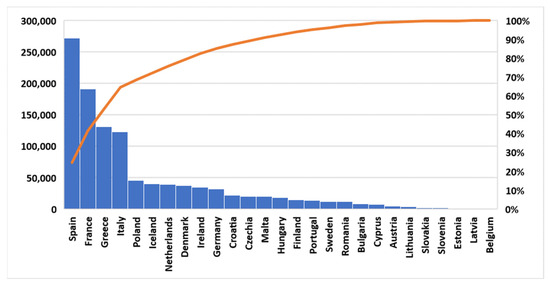
Figure 1.
Production from aquaculture excluding hatcheries and nurseries (tonnes). Source: Eurostat. The line represents cumulative total percentage.
Overall, 64.5% of the total EU aquaculture production is carried out in four countries (Spain, France, Greece and Italy).
Romania has approximately 135,000 ha of freshwater fisheries, which are found at approx. 1000 fish farms located on both public and private patrimony. Regarding the number of licensed units, it is noted that an upward trend has been registered, from 634 units in 2016 to 735 in 2020. This increase is mainly due to the financial support received through European structural funds and investments through operational programs specific to this field, namely the Operational Program for Fisheries (during the 2007–2013 programming period) and the Operational Program for Fisheries and Maritime Development (during the 2014–2020 programming period) [12]. From the perspective of the development potential of this sector, it is noteworthy that: (a) in 2021, approximately 75,423 ha were intended for aquaculture at the level of 968 fish farms and nurseries; (b) Romania has a vast experience in raising fish in environmentally friendly aquaculture technological systems; (c) The hydrographic network is diversified and has a natural heritage of fish interest.
The aquaculture production from Romania was 11.793 tonnes, which represented 1.1% of total EU aquaculture production (Figure 2).
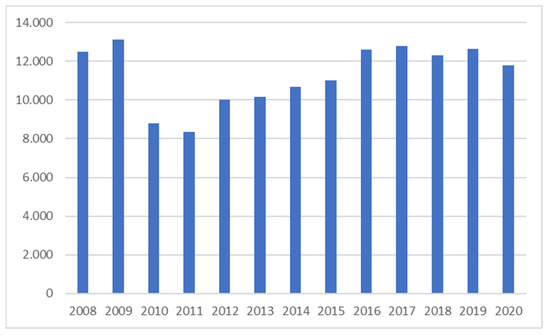
Figure 2.
Dynamics of aquaculture production in Romania (tonnes). Source: Eurostat.
It can be observed that fish production from aquaculture registered an oscillating dynamic during the analyzed period, with a downward trend of approx. 5.6%.
Catches have a significant contribution to the total resources above, which registered a significant upward trend, as can be seen from the following graph (Figure 3).
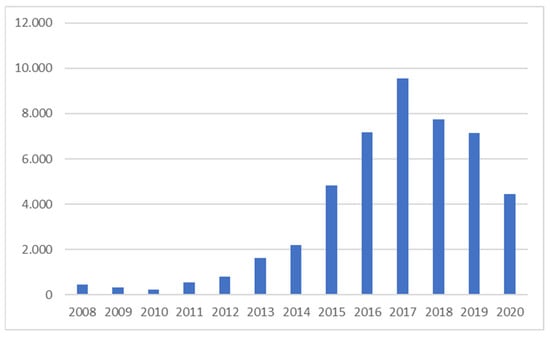
Figure 3.
Dynamics of Catches (tonnes). Source: Eurostat.
In the case of Romania, the average annual consumption of fish is slightly recovering—8 kg at present—representing only 40% of the average consumption worldwide, of which only 17% are of domestic production (11% aquaculture, 2% Black Sea, 4% inland waters, at the level of 2019).
Compared to the mentioned level, we have certain reserves as long as there is no functional fish market in Romania, which can favor the sales of fish on the black market.
The available data regarding the fish market in Romania (Table 1) indicate a growth trend, with aquaculture being the main contributor.

Table 1.
The structure and evolution of the taxed fish market in Romania in the period 2006–2020.
Despite their certain nature, EU fisheries and aquaculture regulations may interfere with certain provisions of national law or various international instruments to which different countries have acceded over time [13], causing legal conflicts to arise that cannot be resolved quickly and consistently by legal practitioners in cross-border disputes [14].
3. Materials and Methods
The main support necessary for the elaboration of the fish resource management models is represented by the evolution of the fish population from an organizational point of view, as a supra-individual biological system [15] and the result of intra- and inter-specific relations.
The processes that characterize the respective intraspecific relations:
- formation and maintenance of the population,
- occupying, organizing and maintaining a territory,
are directly related to the biological yield on which, of course, the interspecific relationships and the ecological conditions make their mark.
The biological model indicates maximum support for the maximum marginal biological yield (MMBY) [16], avoiding the functioning of trophic cycles, but also the economic and social aspects.
Intuitively, however, it states that “maximum sustainable yield should be a guide rather than an optimal operating standard” [16].
In an attempt to introduce into the model/equation the economic aspects, such as fishing effort, it is assumed that at an equal effort a catch is more likely if the fish stock is higher, determining on this basis a curve for the ratio between efficiency and effort, called the Schaefer curve [17].
Reflecting the type of access (free, sole ownership) and the temporal size, two other models of fishery resource management were differentiated: Gordon-Schaefer and Beverton–Holt [18,19].
Gordon Schaefer’s model is based on the following hypotheses [18]:
- access to fishery resources is free, non-discriminatory, capitalizing on this context depending on the economic power and interests of fishermen,
- recognition of the economic cost of fishing, which reflects the effort made to do so,
- for the fish caught, the (functional) market determines the formation/appearance of the unit price.
The model highlights that the size relationships between costs and revenues will differentiate 3 situations:
- abandonment of fishing activity when the costs are higher than the revenues,
- the bio-economic balance is achieved within the limits of the maximum sustainable yield,
- the bio-economic balance is achieved outside the maximum sustainable yield, in which case the resource is overexploited.
We consider the type of access to the fishery resource important as far as putting a mark on the distribution of the advantages of fishing regarding the ratio between the social and the private optimum.
The Beverton–Holt model is a more evolved one, taking into account details about the generations that make up the fish population and that resize the potential level of catches.
The concern for the fisheries management model becoming a reality has led to taking into account the uncertainty regarding the dynamics of biological yield, in the case of the models of Redd (1974–1979) [20] and Charles (1983) [21].
Ultimately, we appreciate that we must choose between the fidelity of one model or another concerning reality and the possibilities of their operationalization.
The brief presentation of the models of application of the principles of sustainability in the management of fishery resources highlights a common aspect, namely the absence of an ecosystem-based approach, which takes into account the ecological yield and external marginal costs/marginal damage/environmental costs in situations where there is an overexploitation of the resource.
Since the energy consumption of any living thing must cover, in order, the maintenance and production needs, the evolution of the biological yield (RB) is properly described by an exponentially aged production function (Figure 4a), which tends asymptotically towards a maximum biological yield (RBM).
The natural limiting factors of yield/production are represented not only by biological characteristics, but also by intra- and inter-specific competition for food/energy, so MBY also indicates the maximum level of the PM fish population.
The ecosystem approach allows us to say that only part of the fish production can be taken, the difference being self-consumption in the ecosystem, which means that we must define not only a biological yield (RB) but also an ecological one (RE), and, accordingly, we can draw the curves of marginal biological yield (RBM) and marginal ecological yield (REM).
Each of the two curves has a maximum, RBMM and REMM, which indicates the optimal fish population from a biological and ecological point of view (POB/E).
The marginal ecological efficiency (EMR), whose maximum level (REMM) must not be exceeded by the sampling activity, is of interest for the fishery resource management model, because it would enter the area of overexploitation of the resource in the area of external environmental damages/costs (negative environmental externalities).
The economic–ecological nature of the fishery resource management model involves taking into account not only the ecological criteria, but also those of an economic and social nature (Figure 4b):
- marginal private cost of resource withdrawal (CMP),
- the private marginal benefit resulting from the withdrawal of the resource as the difference between the maximum marginal ecological yield (in value terms) and the CMP,
- the marginal external cost or marginal environmental damage (CME) that occurs in the case of resource overexploitation (RS).
As long as the level of the exploitation/sampling rate does not exceed the REMM, we can speak of an ecologically sustainable management/ecological exploitation rate (REE), for any exceeding registered environmental damage described by the CME curve (RS).
For economic reasons, the exploitation/sampling rate can exceed REMM until CPM becomes equal to REMM in expression value, respectively, until BMP = 0; the point at which we can speak of an economically optimal fish population (POEc).
The combination of the economic interest of maximizing the net profit/benefit, described by the BMP curve, with the ecological interest (the ratio between POB/E and POEc) implies taking into account the external marginal costs described by the CME curve (RS).
The level of the fish population (P), respectively of the marginal ecological yield, for which the two curves have equal values, can be considered as representing an optimal social level of fish population (POS); for P ≥ POS, the net effect (difference between CME and BMP change) is negative, which means that, in the vicinity of POS, we cannot identify a better solution.
The introduction of royalties on the fishery resource represents an additional cost for the organizations that exploits the resource (the CMP curve rotates to the left), in which case the BMP curve will rotate to the right (the private marginal benefit will decrease as the relationship between CMP and BMP is inversely proportional).
It turns out that the mechanism of operation of royalties will determine a shift of the economically optimal fish population (POEc) to the ecologically optimal fish population (POB/E), having a positive effect on the environment.
This positive effect of the introduction of royalties must be appreciated over its negative social effect on food comfort (because with the same amount of money, the consumer can buy a smaller amount of fish), as well as the loss of gross value added on the fish processing chain (negative economic effect).
Considering that the amplitude of these effects represents:
- 1 = (positive) impact on the natural environment (fish population),
- 2 = (negative) social impact (eating discomfort),
- 3 = (negative) economic impact (gross loss of value added),
for their evaluation and aggregation, we will go through the following stages:
- Determining the effect on the fish demand and implicitly on the protection of the fishery resource, using the fish demand function:
P = price per kg of fish,
q = fish demand,
α (alpha) elasticity coefficient of fish demand depending on the unit price,
- 2.
- Determination of the economic effect, using the method of gross value added,
- 3.
- Establishing the characteristics of the effects and the coefficients of importance of the characteristics in question, using the DELPHI method (Table 2).
- 4.
- Determination of the characterization constant of each form of impact,
- 5.
- Establishing the coefficient of importance of each form of impact, using the DELPHI method,
- 6.
- Determination of the ecological impact.

Table 2.
Qualitative and quantitative level of effect characteristics.
Table 2.
Qualitative and quantitative level of effect characteristics.
| No. Crt. | Feature Name | Symbol | Qualitative Niel | Quantitative Level |
|---|---|---|---|---|
| 1. | Content | C | advantage | +1 |
| disadvantage | −1 | |||
| 2. | Time of production | M | immediate | 1 |
| medium term | 2 | |||
| long term | 3 | |||
| 3. | Persistence | P | temporary | 1 |
| permanent | 3 | |||
| 4. | Reversibility | R | impossible | 1 |
| long term | 2 | |||
| medium term | 3 | |||
| short term | 4 | |||
| 5. | Flexibility | F | in the project phase | 1 |
| in the execution phase | 2 | |||
| in the application phase | 3 |
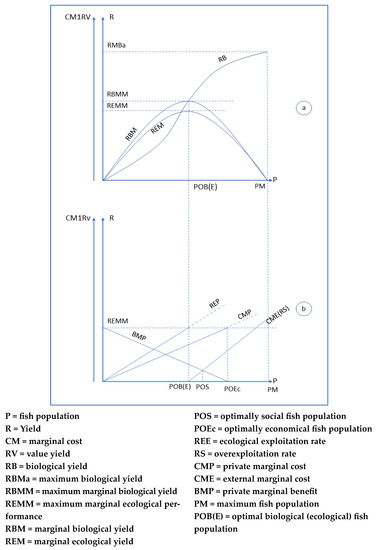
Figure 4.
(a,b) The economic–ecological model for managing fishery resources.
4. Results and Discussion
In the context of the interdependencies between the natural environment as a system and the socioeconomic system, the fisheries resource management model will be a result of harmonizing the functions of the aquatic ecosystem in order to develop the socio-economic system expressed by sustainable development policy (Figure 5).

Figure 5.
Determinants and requirements of the fisheries management model.
We mention that the environmental policy is an integrated component of the sustainable development policy, and the royalties on the fishery resource is an economic/indirect instrument for the operationalization of the environmental policy.
For legal and factual assumption of these aspects, the management model of the fishery resource must meet three fundamental requirements:
- Conservation of aquatic ecosystems,
- Supporting economic competitiveness,
- Meeting consumption needs/requirements.
Assessing the impacts of royalties on the fishery resource requires, first, going through the identification stage (Figure 6).

Figure 6.
Identifying the impacts of introducing royalties on the fishery resource.
The effects generated by the introduction of royalties on the fishery resource are both positive and negative, which requires each time application of a methodology for their aggregation to determine the net effect.
Royalties determine an increase in access to the fishery resource and implicitly the unit price, which will lead to the contraction of fish demand, thus ensuring a premise for achieving the ultimate goal of protecting the resource, but creating food discomfort.
The degree of application of the strategy of the organization that exploits the fishery resource to transfer the cost with royalty to the consumer, through the price, will be found in the evolution of profit; thus, there is a risk of its decrease, entailing measures to rationalize the expenses, including reducing the jobs.
Such an eventuality will generate two final effects, namely the loss of income for the workers and the modification of their lifestyle.
The royalty on fishery resources is also a source of budgetary revenue. Taking into account the purpose of introducing the royalty, at least part of this revenue should be used to support research and improve management capacity in the field, which also means increasing revenue for researchers and administrators.
Thus, we observe a contradictory effect of the royalty on workers’ incomes, specifying those with low incomes, which qualifies the mechanism of the royalty on fishery resources as one of a regressive nature, with professional retraining measures being necessary, in parallel.
Obviously, the regressive character will be even more accentuated (via the decrease in profits) as the level of the royalty will be higher (Figure 7), outlining the risk of substituting the problem of conserving the fishery resource with a social problem, which contradicts sustainable development, which implies a harmonious relationship between environmental, economic and social issues.
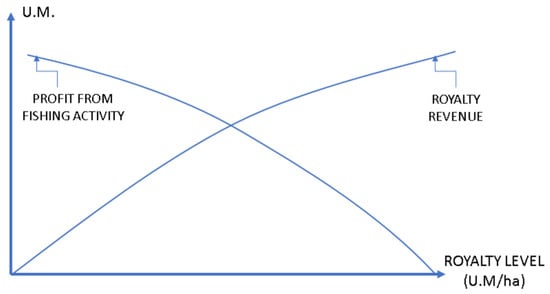
Figure 7.
The evolution of the profit from fishing activity and the income from the royalty on the fishery resource.
In the same terms, it is necessary to analyze the relationship between food discomfort and the protection of fishery resources (Figure 8). A decrease in the regressive nature of the royalty mechanism could be seen in the extent to which the decision-makers will opt for a level R* of the royalty and T* of the transfer of the cost with royalty to the consumer, when the decrease in profitability will be equal to the increase in royalty income, respectively, the increase in the degree of protection of the resource will be equal to the decrease in food comfort.
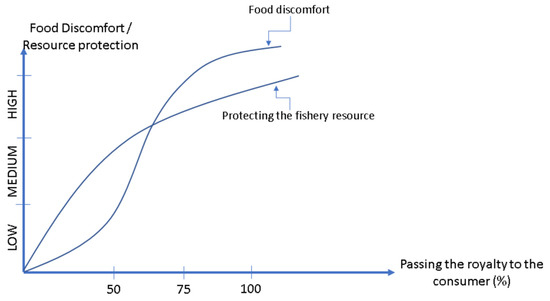
Figure 8.
The dynamics of the protection of the fishery resource and the food inconvenience depend on the transfer of the royalty.
In an attempt to parameterize the ecological–economic model of fishery resource management, we will rely on existing regulations and the evolution of fish demand by price.
Decision 361/2020 on how to calculate the royalty on fishery resources indicates the following formula:
Nr = Rz + Rz(Tap + Taa + Sc + At + Cl + Tr), where:
Nr = royalty level,
Rz = area royalty,
Tap = the type of fish arrangement,
Taa = type of water supply,
Sc = leased area,
At = location of the fishing area in relation to the locality,
Cl = the category of the locality from the cadastral territory,
Tr = transport facilities.
The zones are delimited into four categories, from the climatic point of view, for each zone specifying the minimum and maximum level of productivity/natural yield, and the royalty is established in a percentage of 10% of the maximum yield, evaluated at a price of 1.81 euro/kg (at the BNR exchange rate on the day of the royalty invoicing).
The Danube Delta falls into zone I, for which a maximum yield of 300 kg/ha/year is foreseen, which means that the royalty of the area (Rz) will be equal to 30 kg, and the level of the royalty (Nr.) will be 40 kg/ha/year, respectively, 72.5 euros/ha/year.
The correction coefficients taken into account were the following:
Tap-ponds, natural lakes = 0.00
Taa-gravitational = 0.02
Sc-201–400 ha = 0.03
At-<5 km = 0.04
Cl-the county seat = 0.05
Tr-fluvial = 0.01.
If in the conditions of introducing the royalty, the indicated price is 1.81 euro/kg over the initial price (before the introduction of the royalty) (1.57 euro/kg), considering that the yield of 300 kg over/ha/year is an ecological yield and that until the introduction of the royalty this quantity was absorbed by the market using the demand function with an elasticity coefficient of 1.2, this results in a contraction of fish demand and a reduction in the pressure on the fish population of 12% (from 300 kg. to 262.5 kg.).
The deficit on the market of approximately 38 kg of fish will be found in a gross value-added loss (economic impact) of 672 lei/ha/year:
- Final production lost = 50 kg, of which
- a.
- Semi-preserved fish = 20 kg (40%),
- b.
- Canned fish = 30 kg (60%),
- Average price:
- a.
- Semi-preserved fish 30 lei/kg (6 euro/kg),
- b.
- Canned fish 36 lei/kg (7.2 euro/kg),
- Weighted average price = 33.6 lei/kg (6.7 euro/kg),
- Value of domestic consumption = 20.16 lei/kg (4 euro/kg) (60% of the weighted price),
- Gross value added: 33.6 lei/kg − 20.16 lei/kg = 13.44 lei/kg (2.7 euro/kg),
- Lost gross value added: 50 kg over × 13.44 lei/kg = 672 lei/ha/year (134.4 euro/ha/year),
- Representing a 13% decrease in gross value added.
For the aggregation of the effects on the natural environment and the social and economic fields, we use the following parameters for their characterization (Table 3).

Table 3.
The qualitative and quantitative levels of the parameters used to characterize the impacts.
The average importance of each characteristic (Cj) and the characterization constant of each effect/impact (Ci) are determined based on the following relations:
where
n = quantitative level of the characteristic,
C = importance of the feature,
= average importance of the feature.
i = impact,
j = characteristic
The ecological impact (EI) of the introduction of the royalty on the fishery resource is determined based on the following report and the data from Table 4.
where G represents the importance of the impact, determined using the DELPHI method.

Table 4.
Parameters for determining the ecological impact.
5. Conclusions
1. The use of the economic–ecological model for the management of the fishery re-source supposes a research effort for the determination of the biological and ecological yield of the aquatic ecosystems.
Using an economic–ecological model for fishery management requires substantial research to understand the sustainable limits of harvesting fish from an aquatic ecosystem. This involves determining both the maximum harvest that will not harm the species’ population and the broader impacts of fishing on the ecosystem’s health. This comprehensive approach aims to balance economic interests with the long-term preservation of the ecosystem and its resources.
2. In order to quantify the marginal environmental damage associated with the overexploitation of the fishery resource, it is necessary to identify the methods of evaluation of this ecosystem good/service.
This assessment is crucial to understand the extent of the harm being done, both in terms of the specific resource being exploited (such as a fish population) and the broader ecosystem services that might be affected. By quantifying this damage, policymakers and resource managers can make informed decisions to ensure the sustainability of the fishery resource and minimize the negative effects on the ecosystem and its services.
3. The monitoring of fishing activity must also include informational coverage of the costs and benefits associated with it.
Monitoring should go beyond just tracking catches and should extend to include a thorough understanding of the financial aspects (costs) and positive outcomes (benefits) associated with fishing. This comprehensive approach ensures that decision-makers have a well-rounded view of the entire fishing operation and its implications, enabling them to make informed choices that promote sustainable fishing practices and balance the economic and ecological aspects of the fishery.
4. Ecological impact assessment involves ensuring the possibility of consulting a group of specialists who can decide on the prioritization of impacts and their characteris-tics.
These experts work together to determine the significance of potential impacts on the environment, prioritize them based on their severity and relevance, and analyze the specific characteristics of each impact. This process is essential for informed decision-making, enabling project planners, policymakers, and stakeholders to make environmentally responsible choices and minimize adverse ecological effects.
5. The use of royalties on the fishery resource induces a regressive character to the environmental policy because the group of low-income users is affected.
This could happen if the fees or royalties imposed on fishing activities disproportionately affect individuals or communities with lower incomes who heavily rely on fishing for their livelihoods. In essence, the policy might end up burdening those who are already economically vulnerable, potentially exacerbating inequality. It is important for policymakers to consider the potential socioeconomic impacts of such policies to ensure that they do not inadvertently harm marginalized or disadvantaged groups while aiming to achieve environmental goals.
6. The positive effect of royalties on the fishery resource is offset by the negative economic and social effects, which highlights the need for this economic instrument to be used in a package of measures to correct the negative aspects.
While there are positive benefits, these can be dampened by negative economic and social consequences. To effectively address this balance, the royalty system should be integrated into a holistic approach involving multiple strategies and measures. This broader package of actions aims to mitigate the negative aspects of the royalty system and promote a more balanced and sustainable outcome that aligns with both economic and social objectives.
Concerning the limitations of the research, it should be noted that royalties can be a possible management tool only when it comes to national contexts or bilateral political agreements with the obligation to respect them by all actors involved, otherwise its characteristics and properties can be cancelled, or even more, it can be counterproductive in terms of the economic and social factors of those who respect the rules.
Author Contributions
Conceptualization, C.N. and G.-R.L.; methodology, C.N.; software, G.-R.L.; validation, C.N. and G.-R.L.; formal analysis, C.N.; investigation, C.N.; resources, C.N.; data curation, G.-R.L.; writing—original draft preparation, C.N.; writing—review and editing, G.-R.L.; visualization, C.N.; supervision, C.N.; project administration, C.N.; funding acquisition, G.-R.L. All authors have read and agreed to the published version of the manuscript.
Funding
This research received no external funding.
Institutional Review Board Statement
Not applicable.
Informed Consent Statement
Not applicable.
Data Availability Statement
Data are contained within the article or upon request from the corresponding author.
Conflicts of Interest
The authors declare no conflict of interest.
References
- Stanciu, S.; Mihalcea, L.; Radu, I. The Romanian Fisheries Sector in the EU Context. In Intelligent Development of Fishing Activities in the Lower Prut Area. 2014. Available online: http://www.prut-invest.ugal.ro/images/Sectorul_piscicol_rom%C3%A2nesc_%C3%AEn_context_comunitar.pdf (accessed on 29 June 2023).
- Belacurencu, T. Model de utilizare durabilă a resurselor naturale din Delta Dunării [Model for sustainable use of natural resources in the Danube Delta]. Cercet. Şi Educ. 2007, 4, 75. Available online: http://www.store.ectap.ro/documente/libere/articolfreeECTA4.pdf#page=75 (accessed on 29 June 2023).
- Watson, B.; Reimer, M.N.; Guettabi, M.; Haynie, A. Commercial fisheries & local economies. J. Environ. Econ. Manag. 2021, 106, 102419. [Google Scholar] [CrossRef]
- Valle de Souza, S.; Dollery, B.; Blackwell, B. An empirical analysis of mining costs and mining royalties in Queensland local government. Energy Econ. 2018, 74, 656–662. [Google Scholar] [CrossRef]
- Romanian Government. Emergency Ordinance No 57 of 3 July 2019 on the Administrative Code. Available online: https://legislatie.just.ro/Public/DetaliiDocumentAfis/215925 (accessed on 29 June 2023).
- Romanian Government. Decision 311/2002-Approval of the Concession for the Exploitation of Fisheries Resources. Available online: https://www.cdep.ro/pls/legis/legis_pck.htp_act?ida=40429 (accessed on 20 June 2023).
- Romanian Law 113/2005—Living Aquatic Resources, Fishing and Aquaculture. Available online: https://www.cdep.ro/pls/legis/legis_pck.htp_act?ida=56638 (accessed on 15 June 2023).
- Pascoe, S.; Giles, N.; Coglan, L. Extracting fishery economic performance information from quota trading data. Mar. Policy 2019, 102, 61–67. [Google Scholar] [CrossRef]
- Wakamatsu, M.; Wakamatsu, H. The certification of small-scale fisheries. Mar. Policy 2017, 77, 97–103. [Google Scholar] [CrossRef]
- FAO. The State of World Fisheries and Aquaculture (SOFIA); FAO: Rome, Italy, 2022; ISBN 978-92-5-136364-5. [Google Scholar]
- European Commission, Aquaculture Statistics. 2022. Available online: https://ec.europa.eu/eurostat/statistics-explained/index.php?title=Aquaculture_statistics (accessed on 30 July 2023).
- Order of the Ministry of Agriculture and Rural Development No. 188/05.07.2022 Regarding the Approval of the “Multiannual National Strategic Plan for Aquaculture 2022–2030”. Available online: https://www.anpa.ro/wp-content/uploads/2022/07/188-05.07.2022.pdf (accessed on 30 July 2023).
- Okafor-Yarwood, I.; Belhabib, D. The duplicity of the European Union Common Fisheries Policy in third countries: Evidence from the Gulf of Guinea. Ocean. Coast. Manag. 2020, 184, 104953. [Google Scholar] [CrossRef]
- Coadă, J.C. Dificultăţi Actuale în Domeniul Administrării Resurselor Piscicole ale Mării Negre în Contextul Aplicării Regulamentelor Comunitare în Materie de Pescuit [Current Difficulties in the Management of Black Sea Fisheries Resources in the Context of the Application of Community Fisheries Regulations]. Available online: https://web.p.ebscohost.com/abstract?direct=true&profile=ehost&scope=site&authtype=crawler&jrnl=18446450&AN=151091055&h=iAdjb%2fHGgfHKa9%2bead3%2fD8piPSg5temUKjxZ4M2cwFFFwg4RtwN9Dvik%2boND4t8sZ87EWk2hfw2aYzP0uHCkNQ%3d%3d&crl=c&resultNs=AdminWebAuth&resultLocal=ErrCrlNotAuth&crlhashurl=login.aspx%3fdirect%3dtrue%26profile%3dehost%26scope%3dsite%26authtype%3dcrawler%26jrnl%3d18446450%26AN%3d151091055 (accessed on 29 June 2023).
- Borja, A.; Bremner, J.; Muxika, I.; Rodríguez, J.G. Biological responses at supraindividual levels. In Aquatic Ecotoxicology; Academic Press: Cambridge, MA, USA, 2015; pp. 333–353. [Google Scholar]
- Pillai, S.L.; Thirumilu, P. Fishery, biology and yield estimates of Portunus sanguinolentus off Chennai. J. Mar. Biol. Assoc. India 2012, 54, 73–76. [Google Scholar]
- Strope, R.J.; Schaefer, B.E.; Henden, A.A. Catalog of 93 nova light curves: Classification and properties. Astron. J. 2010, 140, 34. [Google Scholar] [CrossRef]
- Al Qubbanchee, N.A. Continuous and Discrete Models for Optimal Harvesting in Fisheries; Missouri University of Science and Technology: Rolla, MO, USA, 2022. [Google Scholar]
- Plank, M.J. Balanced harvesting is the bioeconomic equilibrium of a size-structured Beverton-Holt model. ICES J. Mar. Sci. 2017, 74, 112–120. [Google Scholar] [CrossRef][Green Version]
- Wollebæk, J.; Thue, R.; Heggenes, J. Redd site microhabitat utilization and quantitative models for wild large brown trout in three contrasting boreal rivers. North Am. J. Fish. Manag. 2008, 28, 1249–1258. [Google Scholar] [CrossRef]
- Charles, A.T. Optimal fisheries investment under uncertainty. Can. J. Fish. Aquat. Sci. 1983, 40, 2080–2091. [Google Scholar] [CrossRef]
Disclaimer/Publisher’s Note: The statements, opinions and data contained in all publications are solely those of the individual author(s) and contributor(s) and not of MDPI and/or the editor(s). MDPI and/or the editor(s) disclaim responsibility for any injury to people or property resulting from any ideas, methods, instructions or products referred to in the content. |
© 2023 by the authors. Licensee MDPI, Basel, Switzerland. This article is an open access article distributed under the terms and conditions of the Creative Commons Attribution (CC BY) license (https://creativecommons.org/licenses/by/4.0/).